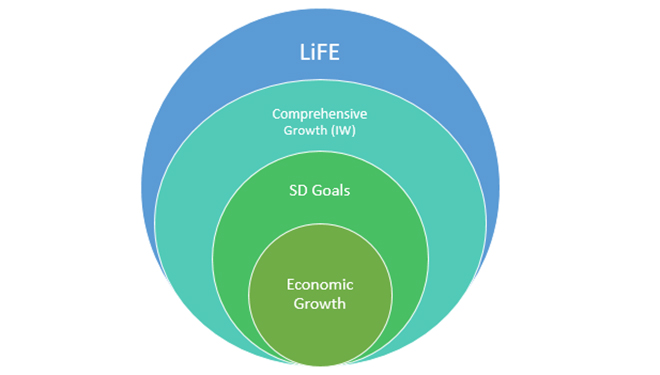Introduction:
In a global landscape marked by unprecedented challenges and the imperative for sustainable development, the Inclusive Wealth Report emerges as a transformative instrument. Far beyond the narrow confines of traditional economic indicators like GDP, this report embarks on a mission to redefine how we perceive and measure a nation’s prosperity. It’s a journey that transcends monetary metrics, embracing a holistic vision that incorporates economic, natural, human, and social capital.
The Four Capitals:
Economic Capital:
At the core of economic analysis, traditional indicators only scratch the surface. The Inclusive Wealth Report recognizes that true economic wealth extends beyond GDP. It scrutinizes not only the financial gains but also the quality and sustainability of economic activities. Produced capital and infrastructure take center stage, providing a nuanced understanding of a nation’s economic health.
Natural Capital:
Environmental sustainability lies at the heart of the Inclusive Wealth Report. Beyond mere acknowledgment, the report evaluates a country’s natural capital — its resources, biodiversity, and overall ecological health. By quantifying and assessing the impact of human activities on the environment, it provides a clear picture of a nation’s commitment to ecological stewardship.
Human Capital:
The skills, health, and education of a population are invaluable assets often overlooked by conventional economic metrics. The Inclusive Wealth Report acknowledges the pivotal role of human capital in driving a nation’s prosperity. It delves into the well-being of individuals, recognizing that a thriving populace is the bedrock of sustainable development.
Social Capital:
Societal structures, trust, and social cohesion are integral to a nation’s fabric. The Inclusive Wealth Report goes beyond individual achievements, recognizing the strength of communities and their impact on collective well-being. Social capital becomes a key dimension, highlighting the importance of inclusive and cohesive societies.
Sustainability at its Core:
Long-Term Consequences:
Sustainability is not an afterthought but a guiding principle of the Inclusive Wealth Report. It shifts the focus from short-term gains to the enduring impact of a nation’s development choices. By scrutinizing resource usage and environmental impacts, the report lays bare the potential long-term consequences of current practices.
Equity Matters:
Inclusive Prosperity:
The Inclusive Wealth Report stands as a staunch advocate for inclusive prosperity. It’s not just about the total wealth of a nation; it’s about how that wealth is distributed among its citizens. The emphasis on equity ensures that economic progress benefits all segments of society, preventing the deepening of social disparities.
Methodology Unveiled:
Dynamic Assessment:
Behind the scenes, a sophisticated methodology unfolds. The Inclusive Wealth Report doesn’t just provide static numbers; it offers a dynamic assessment. It quantifies and compares different forms of capital, tracking their changes over time. This dynamic approach provides a nuanced understanding of a nation’s development trajectory.
Policy Implications:
Guiding Decision-Making:
For policymakers navigating the complex terrain of governance, the Inclusive Wealth Report isn’t a mere compilation of statistics. It’s a roadmap, offering nuanced insights for informed decision-making. Policymakers can draw on these insights to formulate strategies that prioritize sustainability, inclusivity, and the long-term well-being of their constituents.
Global Perspectives and Case Studies:
Beyond Borders:
The impact of the Inclusive Wealth Report extends far beyond national boundaries. A global overview sets the stage, offering a macroscopic view of inclusive wealth trends and changes over time. Country-specific analyses zoom in, providing detailed portraits of individual nations and their diverse approaches to inclusive prosperity. Case studies then spotlight success stories, showcasing instances where nations have effectively managed and enhanced their inclusive wealth.
Challenges, Opportunities, and the Path Forward:
Acknowledging Obstacles:
No comprehensive report would be complete without acknowledging challenges. The Inclusive Wealth Report identifies obstacles that nations face in achieving inclusive wealth. By recognizing these challenges, the report becomes a tool not just for celebration but for introspection and improvement.
Opportunities for Progress:
Amid challenges lie opportunities. The Inclusive Wealth Report is not a static document; it’s a dynamic instrument that identifies opportunities for progress. It serves as a guide for nations to learn from each other, adapt successful strategies, and chart a course toward a more sustainable and inclusive future.
Conclusion:
A Manifesto for Change:
In an era where sustainability and inclusivity are not just buzzwords but imperatives, the Inclusive Wealth Report emerges as more than a report — it’s a manifesto. It’s a call to action, challenging nations to reassess their definition of wealth and prosperity. It’s an invitation to build a future where economic growth is not divorced from environmental stewardship, where human and social capital are nurtured alongside economic gains.
As we navigate the complexities of global development, the Inclusive Wealth Report stands as a beacon, illuminating a path toward holistic prosperity. It’s not just a document; it’s a vision for a balanced, equitable, and sustainable world.
Best regards,
John Terry
Wealth Improved

